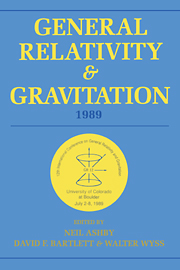 General Relativity and Gravitation, 1989
General Relativity and Gravitation, 1989 Published online by Cambridge University Press: 05 March 2012
The study of exact solutions and exact properties of Einstein's equations is a rather broad mathematical subfield of general relativity. Of the roughly 80 abstracts submitted to the symposium devoted to this topic, time limitations permitted only a small fraction to be presented orally. Table 1 lists the papers given at the two sessions of this symposium. The 16 presented papers fall roughly within the categories of “exact solutions,” “gravitational energy,” “mathematical results” and “symmetry properties of Einstein's equations” and are briefly discussed under those headings in the following. Since most of the oral presentations described extremely recent research results, they did not, for the most part, include references to published papers concerning these results. For this reason the attached reference list is extremely sketchy.
Exact solutions
Virtually all of the known exact solutions of Einstein's equations involve some significant element of idealization. One usually imposes a stringent geometrical symmetry upon the solutions to be considered and, in the non-vacuum case, simplifying assumptions upon the matter sources to be included. Goenner and Sippel discussed several classes of exact solutions which, though highly idealized in the geometrical sense (being in fact pp waves), were nevertheless more realistic in their material content. The sources included both Maxwell fields and a viscous, heat-conducting plasma subject to certain natural energy and entropy inequalities. Several classes of solutions were discussed which represented the generation of a gravitational wave by an electromagnetic wave and a temperature wave propagating in the viscous gas.
To save this book to your Kindle, first ensure [email protected] is added to your Approved Personal Document E-mail List under your Personal Document Settings on the Manage Your Content and Devices page of your Amazon account. Then enter the ‘name’ part of your Kindle email address below. Find out more about saving to your Kindle.
Note you can select to save to either the @free.kindle.com or @kindle.com variations. ‘@free.kindle.com’ emails are free but can only be saved to your device when it is connected to wi-fi. ‘@kindle.com’ emails can be delivered even when you are not connected to wi-fi, but note that service fees apply.
Find out more about the Kindle Personal Document Service.
To save content items to your account, please confirm that you agree to abide by our usage policies. If this is the first time you use this feature, you will be asked to authorise Cambridge Core to connect with your account. Find out more about saving content to Dropbox.
To save content items to your account, please confirm that you agree to abide by our usage policies. If this is the first time you use this feature, you will be asked to authorise Cambridge Core to connect with your account. Find out more about saving content to Google Drive.